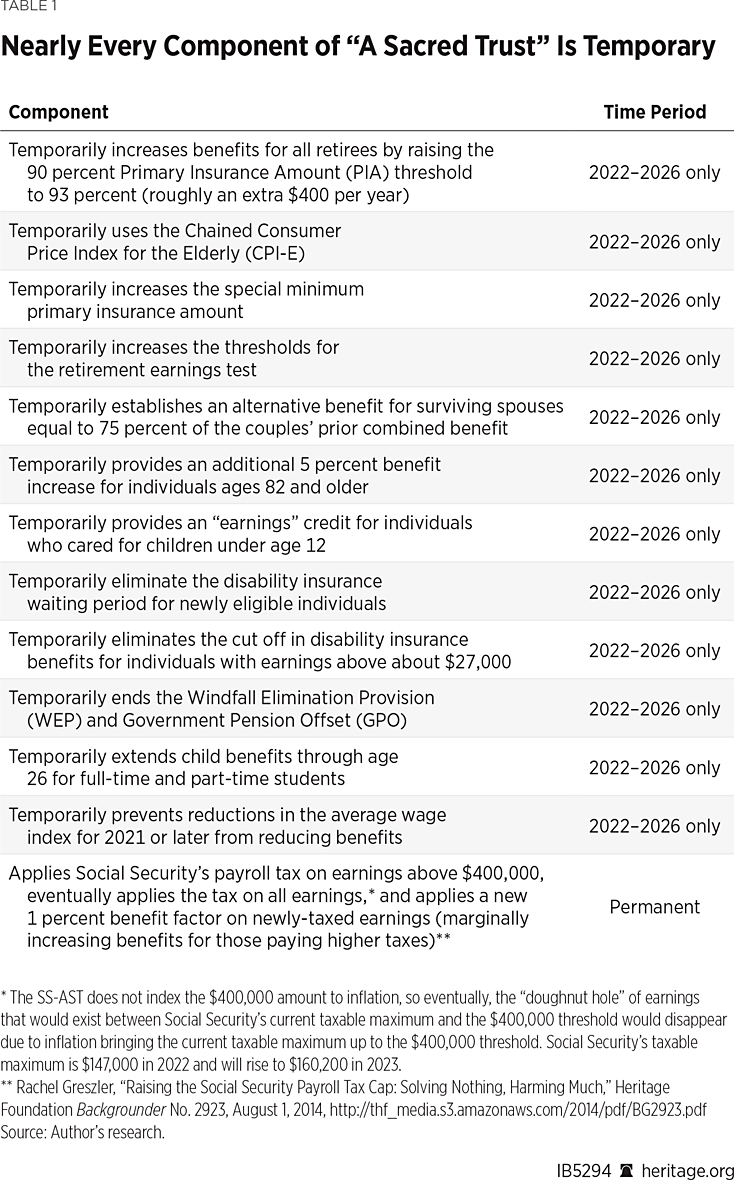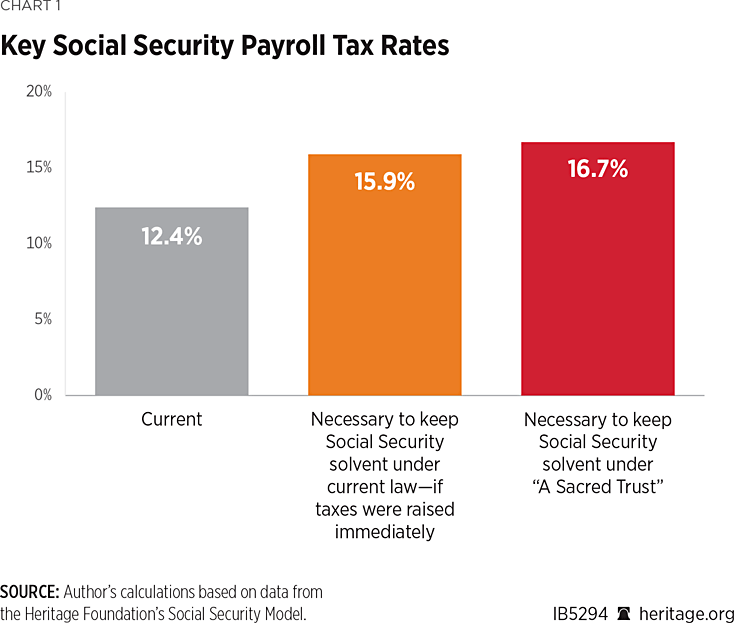America’s Social Security program is running out of time and money. Policymakers cannot agree on how to fix it, and generations of Americans have been duped into believing it is a good deal. Now, lawmakers who want to expand Social Security are further misleading Americans by claiming that it is possible to fix Social Security and to provide big benefit increases simply by taxing the “rich.” Specifically, 202 House Democrats have co-sponsored the Social Security 2100: A Sacred Trust (SS-AST) legislation, a dishonest proposal that promises five years of various benefit increases based on 75 years’ worth of tax increases.
The Heritage Foundation’s Social Security model estimates that if the bill’s benefit and tax increases were made permanent, SS-AST would exacerbate Social Security’s shortfalls by 21 percent and cause the program to run out of money two years earlier than currently projected, in 2032. In fact, maintaining Social Security’s long-term solvency under the bill would require a new 34 percent increase in the payroll tax, from 12.4 percent to 16.67 percent.REF
Social Security needs real solutions but it is reckless and dangerous for politicians to support a disingenuous proposal that will ultimately make Social Security and its participants worse off.REF
Social Security’s Hard Truth
The Social Security Trustees 2022 report projects that Social Security’s retirement program, known as Old Age and Survivor’s Insurance (OASI), will be insolvent in 2034, resulting in 23 percent across-the-board benefit cuts.REF That means that no one who is currently 55 or younger will receive a single full retirement benefit before the program runs out of money, and about 60 million people who are already retired and collecting benefits in 2034 will be subject to cuts averaging $4,400 per year.
Despite the common myth that workers’ payroll taxes have been set aside to fund their future retirement benefits, Social Security has been operating in the red for 12 years, paying out more in benefits than it collects in taxes. It can do this because when previous Social Security taxes exceeded the benefits paid, the government spent what the American public thought was being set aside for Social Security on other programs and credited Social Security’s trust fund with IOUs. Cashing in on those IOUs, as is happening now, requires the Treasury to issue more publicly held debt.
Despite the myth that workers’ payroll taxes have been set aside to fund their retirement, Social Security has been operating in the red for 12 years, paying out more in benefits than it collects in taxes.
Social Security was supposed to be a social safety net, providing benefits for people who live longer than expected and run out of savings and for those who experience hardships, such as the premature death of a family’s breadwinner. But what started as a small program that took 2 percent of workers’ paychecks and promised never to take more than 6 percent now takes more than twice that amount while providing significantly higher benefits to a broader population, over significantly longer life spans. As a result, while past and current retirees have on average received far more from Social Security than they paid in taxes (though usually less than they would have earned if those taxes were invested in a personal retirement account), current and future workers will get a raw deal.REF
Paying out more in benefits than government collects in taxes to pay for them is the oldest short-term political trick in the book. Add to this the fact that fully half of Social Security’s taxesREF are hidden from taxpayers and one can understand Social Security’s political popularity. Social Security’s too-good-to-be-true design has amassed $20.4 trillion in unfunded obligations—that is $157,000 per household. Maintaining the current system’s benefits would require an immediate 26 percent increase in the payroll tax, while preventing insolvency without tax increases would require an immediate 20 percent benefit cut. Social Security’s ability to provide windfall benefits is nearing its end; the program long ago lost its “insurance” function and has become a giant intergenerational transfer program that is a bad deal for current and future workers.
Reform Is Inevitable
Despite its name, Social Security is anything but secure. Simply put, Social Security as Americans have known it will no longer be possible in a dozen years. Americans deserve to know what will happen if policymakers do nothing, and what could happen under viable reform options. Following is what will happen if Congress:
Does Nothing. Absent congressional action, Social Security’s trust fund will run out of money in 2034, its combined old-age and disability insurance (DI) trust funds will run out of money in 2035, and all benefits will be reduced by 23 percent across the board, with larger benefit cuts necessary over time.REF Workers will continue to pay 12.4 percent of their wages into Social Security’s combined old-age and DI programs.
Increases Taxes. Maintaining Social Security in its current form would require an immediate payroll tax hike, from 12.4 percent to 15.82 percent. This hike would amount to an additional $2,290 in annual taxes for the median household and a total Social Security tax bill of $11,070.REF
Alternatively, if policymakers wait until 2035, when Social Security’s old-age and DI programs run out of money, taxes would need to rise to 16.47 percent. This would amount to an additional $2,880 in annual taxes for the median household and a total annual Social Security tax bill of $11,660.
Reduces Benefits. Preserving Social Security’s solvency would require an immediate 20 percent across-the-board benefit reduction. This reduction would amount to a $4,000 annual benefit cut for the average retired worker.REF If policymakers wait until 2035, when Social Security’s old-age and DI programs run out of money (the do-nothing scenario), benefits would need to be cut 23 percent, or by $4,600, and cuts would continue to rise over time.
Enacts Comprehensive Reform. Instead of relying exclusively on benefit cuts or tax increases, policymakers could protect Social Security’s solvency through a combination of reforms that could also include measures like raising the retirement age and indexing it to life expectancy, using a more accurate inflation index,REF altering the benefit formula, and adding a personal wealth-building component.
To date, federal lawmakers have introduced two very different comprehensive Social Security reform proposals that would make Social Security solvent in the long run. The Social Security Reform Act of 2016 would have increased benefits for lower-income earners, gradually reduced benefits for middle-income and upper-income earners, and modernized the program through increases in the eligibility age and the use of more accurate inflation adjustments.REF An opposite approach to solvency was the SS-AST’s immediate predecessor, called the Social Security 2100 Act (introduced in the 116th Congress).REF The Social Security 2100 Act would have significantly increased taxes and benefits for all workers and retirees, shifted to an inferior inflation measure, and was estimated to lead to a smaller economy and lower incomes.REF But unlike the SS-AST, the Social Security 2100 Act would have led to solvency.
Sham Solution: “Social Security 2100: A Sacred Trust” Would Hasten Insolvency and Exacerbate Shortfalls
SS-AST was introduced in the 117th Congress. The proposal couples 75 years of tax increases with over a dozen benefit increases that expire after five years, in 2026. Table 1 describes SS-AST’s major components.

Even with 75 years of tax increases and only five years of benefit increases, SS-AST would not make Social Security solvent. The Social Security Administration estimated that SS-AST would reduce Social Security’s combined OASI and DI long-run shortfalls by about only half, from 3.54 percent of payroll to 1.71 percent of payroll and would extend the programs’ solvency by four years, from 2034 to 2038.REF
But those estimates are based on an entirely fanciful assumption—that the bill’s sponsors actually intend to sunset the benefit increases after only five years.
If all 12 of Social Security 2100: A Sacred Trust’s temporary benefit increases were made permanent, Social Security would run out of money two years earlier—in 2032 instead of 2034.
The Heritage Foundation’s Social Security Model estimates that if all 12 of SS-AST’s temporary benefit increases were made permanent, Social Security would run out of money two years earlier, in 2032 instead of 2034.REF Benefit cuts in 2032 would be greater than the roughly 23 percent cuts that would apply in 2034 under current law because the bill raises benefits to a higher level prior to insolvency. Enacting a permanent version of SS-AST would exacerbate Social Security’s shortfalls by 21 percent, increasing them from 3.54 percent of payroll to 4.27 percent of payroll.
Even with SS-AST’s massive tax hikes on higher-income earners, the proposal’s expansion of benefits would still require a 34 percent, across-the-board payroll tax increase, bringing the current 12.4 percent tax to 16.67 percent. A permanent version of SS-AST would require an extra $3,000 per year in Social Security taxes, and $11,800 per year in total Social Security taxes for the median household.

A Heritage Foundation analysis of the personal impacts of the SS-AST’s predecessor bill (the 116th Congress version, which massively increased taxes but achieved solvency) found that workers of all income levels would be better off, with higher incomes in retirement, if they were allowed to keep the money they would have to pay for the proposed tax hikes and instead save that money in a personal account.REF That same analysis holds true for SS-AST, but the magnitude of the potential losses to workers’ future financial well-being would be even greater considering the larger tax increases needed to sustain SS-AST.
Conclusion
Social Security’s future is not secure. The program is running out of time and money, and recent increases in debt and spending have crowded out options for reform. SS-AST is a dishonest distraction from serious proposals that would make Social Security solvent for the long run. By recognizing the budget deception of labeling what are intended to be permanent benefit increases “temporary,” one can see that SS-AST would increase Social Security’s shortfalls by 21 percent and cause the program to run out of money two years earlier, in 2032. Maintaining benefit increases and preventing insolvency under SS-AST would require a 34 percent tax increase—an extra $3,000 for the median household.
In contrast, The Heritage Foundation’s proposals to modernize the program and shift to a universal benefit—that keeps more people out of poverty and provides workers an ownership option—would achieve long-run solvency, pave the way for Social Security’s tax to decline nearly 20 percent, to 10.1 percent, and provide an extra $1,600 in take-home pay for the median household.REF In addition to higher earnings and larger retirement incomes for everyone, lower-income workers would benefit the most as they would receive higher benefits, pay less in taxes, and gain the opportunity to build personal wealth.
Social Security is politically difficult to reform, but it is absolutely necessary to protect the most vulnerable Americans from the consequences of an unsustainable system. While there is no way to undo past excesses that have made Social Security seem like a more beneficial program than it is, Congress can refocus the program on its original purposes: providing financial security and protecting seniors from poverty. By reducing Social Security’s drag on personal incomes and nest eggs, it is possible to make more people—and the entire economy—better off.
Rachel Greszler is Senior Research Fellow for Budget and Entitlements in the Grover M. Hermann Center for the Federal Budget at The Heritage Foundation.


